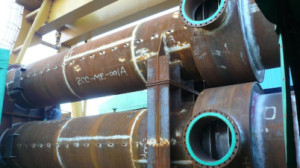Corrosion behaviour of Inconel alloys in atmospheric conditions
The corrosion rates of materials are affected by local environments, atmospheres are usually categorized as: Rural, Industrial and Marine.
Further classifications like urban, arctic and tropical can be considered. However, the major concern is for the above main types. The rural area with nominal or medium manufacturing operations, or with dry atmospheric conditions, has less issues of atmospheric corrosion.
In the industrial environments, various types of contamination by sulfur in the form of sulfur dioxide or hydrogen sulfide are essential. Burning of fossil fuels produces a large magnitude of sulfur dioxide that is transformed to sulfuric and sulphurous acid in the presence of moisture. The combustion of these fossil fuels and hazardous waste products should develop only carbon dioxide, water vapour and inert gas as combustion products. This is the rare case. Depending on the contaminants present in the fossil fuel, the chemical composition of the dangerous waste materials incineration and the combustion conditions occurred, various other compounds can be developed.
Besides to the common contaminants, pollutants like hydrogen chloride, chloride, hydrogen fluoride and hydrogen bromide are developed as combustion products from the burning of chemical materials. During incineration of organophosphorus compounds, corrosive phosphorous compounds are developed. Chlorides are also produced in municipal incinerators.
Road traffic and energy development result into the production of NOx that is oxidized to nitric acid. The antipollution regulations that have been enacted do not prevent the escape in the atmosphere of magnitudes of these materials adequate to prevent corrosion issues. The corrosivity of an industrial atmosphere reduces with increase in distance from the city.
Marine conditions are exposed to chloride corrosion causing deposition of fine drops of crystals developed by evaporation of spray has been flown by wind from the sea. The magnitude of chloride accumulation from the marine condition is directly proportional to the distance from the shore. Closer to the shore, more the deposition and effect of corrosion.
Due to these different conditions, a material that is resistant to atmospheric corrosion in one region may not offer satisfactory performance in another. For instance, galvanized iron is suitable for service in rural conditions however it is not fit when subjected to industrial conditions. Contamination from industrial or marine areas can find its ways in these areas based on the prevailing winds and other atmospheric conditions. Indoor conditions may be not much corrosive or subject to vigorous corrosion near to a pickling bath in a steel mill.
Atmospheric conditions should be specified in terms of temperature, humidity, and contaminants and as well as their corrosivity to specific materials of construction being considered. Besides to the general atmospheric condition, various conditions like cooling tower drift or spray, spills, or water release or chemicals should not be ignored and should be specified in terms of temperature, humidity and contaminants and their corrosivity to various manufacturing materials should be considered. Besides to the general atmospheric condition, various atmospheric conditions like cooling tower drift or spray, spills or releases of water or chemicals should not be ignored and must be considered.
There are major nickel alloys that are recommended for service in atmospheric conditions such as Hastelloy B2, Hastelloy C276, Inconel 625, Inconel 718 and others.
Hastelloy B2 has rich nickel content, it is resistant to chloride induced stress corrosion cracking and pitting corrosion in various acid chloride conditions.
Applications of Inconel 625 are in fields where high strength and corrosion resistance are required. It offers outstanding fatigue strength and superior strength and toughness at temperatures varying from cryogenic to 2000oF.
Hastelloy C276 is resistant to itnergranular corrosion in various oxidizing and chloride based conditions. It can be used in most applications in the as-welded condition.


